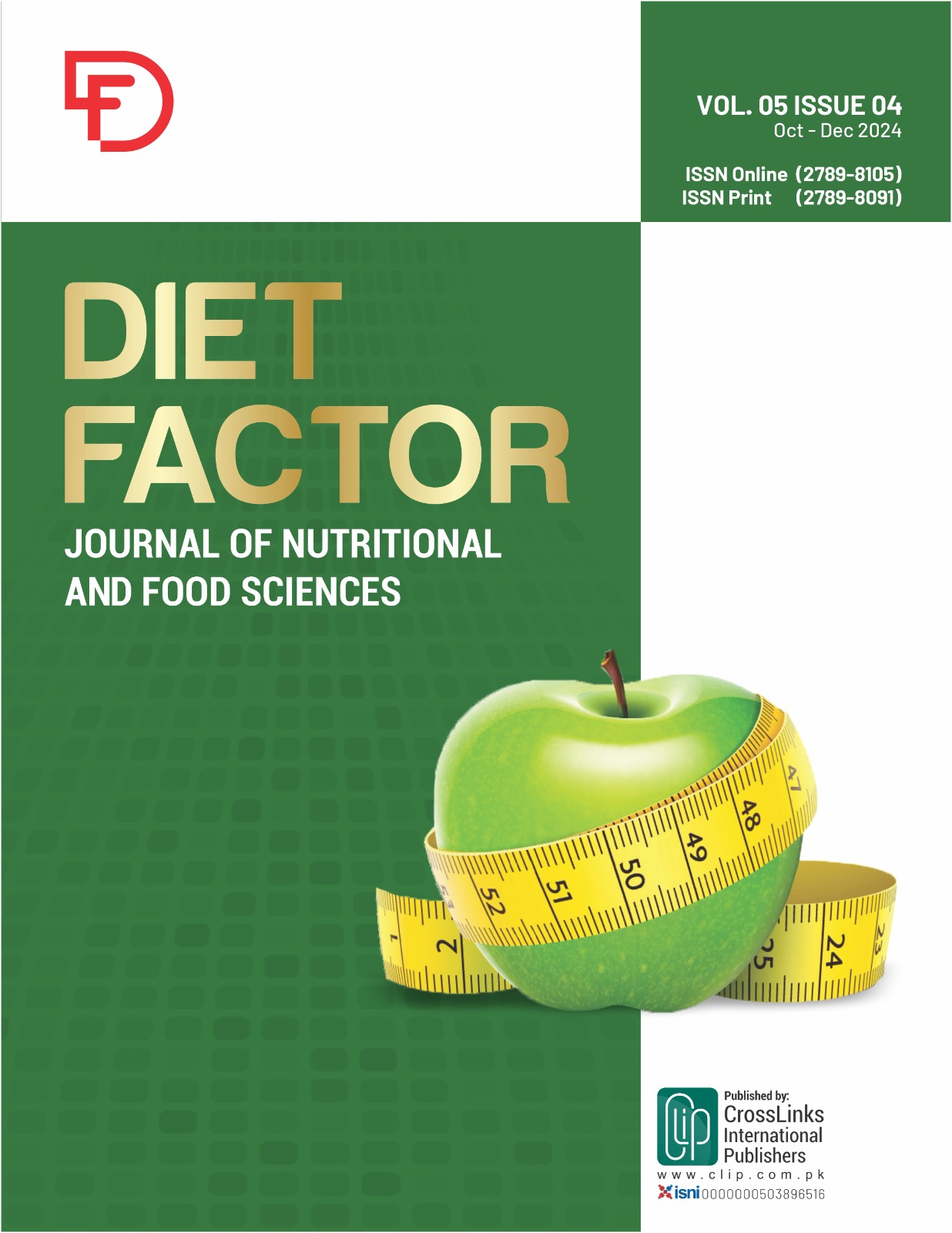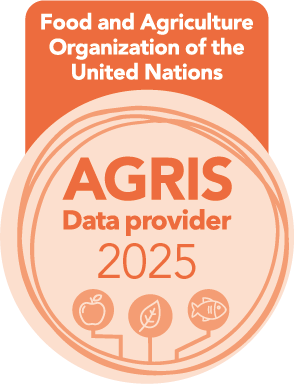Determination of the Temperature and Time Required for Formation of Safe Levels of Acrylamide in Bakery Products
Temperature and Time for Formation of Acrylamide in Bakery Products
DOI:
https://doi.org/10.54393/df.v5i04.135Keywords:
Acrylamide, Temperature, Time, Bakery ProductsAbstract
Acrylamide as a toxic and carcinogenic substance is produced naturally during high-temperature methods used in baking. Objectives: To evaluate the temperature and time required for the formation of safe levels of acrylamide in bakery products. Methods: All developed bakery products were evaluated for their chemical elements i.e. fiber, moisture, ash, protein, crude, and crude fat were calculated according to their relevant methods. Bakery product ingredients were procured from the local market of Lahore. Furthermore, developed products were quantified for acrylamide concentration using high-performance liquid chromatography (HPLC) technique. Three samples were prepared Control group (T0), Treatment plan 1 (T1), Treatment plan 2 (T2). From each group, 10g of sample was procured for analysis. Results: Pizza treated at T0 (220°C, 15min), T1 (210°C, 20 mints), and T2 (230°C, 10 min) had the following concentration of acrylamide (15.66 ± 3.05, ND, 32.33 ± 2.08 µ/kg), T0 (18°◦C, 20 mints), T1 (175°C, 25 mints), T2 (195◦C, 15 mints), showed acrylamide as (66.66 ± 2.51, 42.66 ± 3.05, 90 ± 1.73 µ/kg) and Cake T0 (160-15 mints), T1 (150-20 mints), T2 (170◦C, 10mins) acrylamide quantified (15.66 ± 2.51, ND, 34.33 ± 2.08µ/kg) and Biscuit (66.66 ± 2.51, 42.66.33 ± 3.05, 90 ± 1.73µ/kg). Conclusions: It was concluded that treating T1 (210°C for 20 mints -ND), To (175°C for 25 mints - 48.33 µ/kg), and T3 (150°C for 20 mints-ND) can reduce and mitigate the formation of acrylamide following. Low temperature and high time could serve as an efficient strategy to reduce acrylamide and optimize the process.
References
Rice JM. The Carcinogenicity of Acrylamide. Mutation Research/Genetic Toxicology and Environmental Mutagenesis. 2005 Feb; 580(1-2): 3-20. doi: 10.1016/j.mrgentox.2004.09.008 DOI: https://doi.org/10.1016/j.mrgentox.2004.09.008
Besaratinia A and Pfeifer GP. A Review of Mechanisms of Acrylamide Carcinogenicity. Carcinogenesis. 2007 Mar; 28(3): 519-28. doi: 10.1093/carcin/bgm006. DOI: https://doi.org/10.1093/carcin/bgm006
Pelucchi C, Galeone C, Levi F, Negri E, Franceschi S, Talamini R et al. Dietary Acrylamide and Human Cancer. International Journal of Cancer. 2006 Jan; 118(2): 467-71. doi: 10.1002/ijc.21336. DOI: https://doi.org/10.1002/ijc.21336
Yousef MI and El-Demerdash FM. Acrylamide-Induced Oxidative Stress and Biochemical Perturbations in Rats. Toxicology. 2006 Feb; 219(1-3): 133-41. doi: 10.1016/j.tox.2005.11.008. DOI: https://doi.org/10.1016/j.tox.2005.11.008
Claus A, Carle R, Schieber A. Acrylamide in Cereal Products: A Review. Journal of Cereal Science. 2008 Mar; 47(2): 118-33. doi: 10.1016/j.jcs.2007.06.016. DOI: https://doi.org/10.1016/j.jcs.2007.06.016
Cogswell ME, Patel SM, Yuan K, Gillespie C, Juan W, Curtis CJ et al. Modelled Changes in US Sodium Intake from Reducing Sodium Concentrations of Commercially Processed and Prepared Foods to Meet Voluntary Standards Established in North America: NHANES. The American Journal of Clinical Nutrition. 2017 Aug; 106(2): 530-40. doi: 10.3945/ajcn.116.145623. DOI: https://doi.org/10.3945/ajcn.116.145623
Cappelli A, Lupori L, Cini E. Baking Technology: A Systematic Review of Machines and Plants and Their Effect On Final Products, Including Improvement Strategies. Trends in Food Science and Technology. 2021 Sep; 115: 275-84. doi: 10.1016/j.tifs.2021.06.048. DOI: https://doi.org/10.1016/j.tifs.2021.06.048
Singh P, Goyal GK. Functionality of Pizza Ingredients. British Food Journal. 2011 Oct; 113(11): 1322-38. doi: 10.1108/00070701111179960. DOI: https://doi.org/10.1108/00070701111179960
Sarion C, Codină GG, Dabija A. Acrylamide in Bakery Products: A Review On Health Risks, Legal Regulations and Strategies to Reduce Its Formation. International Journal of Environmental Research and Public Health. 2021 Apr; 18(8): 4332. doi: 10.3390/ijerph18084332. DOI: https://doi.org/10.3390/ijerph18084332
Fernandes CL, Carvalho DO, Guido LF. Determination of Acrylamide in Biscuits by High-Resolution Orbitrap Mass Spectrometry: A Novel Application. Foods. 2019 Nov; 8(12): 597. doi: 10.3390/foods8120597. DOI: https://doi.org/10.3390/foods8120597
Esposito F, Velotto S, Rea T, Stasi T, Cirillo T. Occurrence of Acrylamide in Italian Baked Products and Dietary Exposure Assessment. Molecules. 2020 Sep; 25(18): 4156. doi: 10.3390/molecules25184156. DOI: https://doi.org/10.3390/molecules25184156
Žilić S, Aktağ IG, Dodig D, Filipović M, Gökmen V. Acrylamide Formation in Biscuits Made of Different Wholegrain Flours Depending On Their Free Asparagine Content and Baking Conditions. Food Research International. 2020 Jun; 132: 109109. doi: 10.1016/j.foodres.2020.109109. DOI: https://doi.org/10.1016/j.foodres.2020.109109
Andačić IM, Tot A, Ivešić M, Krivohlavek A, Thirumdas R, Barba FJ et al. Exposure of the Croatian Adult Population to Acrylamide Through Bread and Bakery Products. Food Chemistry. 2020 Aug; 322: 126771. doi: 10.1016/j.foodchem.2020.126771. DOI: https://doi.org/10.1016/j.foodchem.2020.126771
Ade IC, Ingbian EK, Abu JO. Physical, Chemical and Sensory Properties of Baked Products from Blends of Wheat and African Yam Bean (Sphenostylis Stenocarpa) Water-Extractable Proteins. Nigerian Food Journal. 2012 Jan; 30(1): 109-15. doi: 10.1016/S0189-7241(15)30019-9. DOI: https://doi.org/10.1016/S0189-7241(15)30019-9
Kirkland JJ. Development of Some Stationary Phases for Reversed-Phase HPLC. Journal of Chromatography A. 2004 Dec; 1060(1-2): 9-21. doi: 10.1016/S0021-9673(04)01892-8. DOI: https://doi.org/10.1016/S0021-9673(04)01892-8
Michalak J, Czarnowska-Kujawska M, Klepacka J, Gujska E. Effect of Microwave Heating On the Acrylamide Formation in Foods. Molecules. 2020 Sep; 25(18): 4140. doi: 10.3390/molecules25184140. DOI: https://doi.org/10.3390/molecules25184140
Crawford LM, Kahlon TS, Chiu MC, Wang SC, Friedman M. Acrylamide Content of Experimental and Commercial Flatbreads. Journal of Food Science. 2019 Mar; 84(3): 659-66. doi: 10.1111/1750-3841.14456. DOI: https://doi.org/10.1111/1750-3841.14456
Eerola S, Hollebekkers K, Hallikainen A, Peltonen K. Acrylamide Levels in Finnish Foodstuffs Analyzed with Liquid Chromatography Tandem Mass Spectrometry. Molecular Nutrition and Food Research. 2007 Feb; 51(2): 239-47. doi: 10.1002/mnfr.200600167. DOI: https://doi.org/10.1002/mnfr.200600167
Hai YD, Tran-Lam TT, Nguyen TQ, Vu ND, Ma KH, Le GT. Acrylamide in Daily Food in the Metropolitan Area of Hanoi, Vietnam. Food Additives and Contaminants: Part B. 2019 Jul; 12(3): 159-66. doi: 10.1080/19393210.2019.1576774. DOI: https://doi.org/10.1080/19393210.2019.1576774
Davoodi S, SA AR, Soleimanian A, Jahromi AF. Application of a Novel Acrylamide Copolymer Containing Highly Hydrophobic Comonomer as Filtration Control and Rheology Modifier Additive in Water-Based Drilling Mud. Journal of Petroleum Science and Engineering. 2019 Sep; 180: 747-55. doi: 10.1016/j.petrol.2019.04.069. DOI: https://doi.org/10.1016/j.petrol.2019.04.069
Downloads
Published
How to Cite
Issue
Section
License
Copyright (c) 2024 DIET FACTOR (Journal of Nutritional and Food Sciences)

This work is licensed under a Creative Commons Attribution 4.0 International License.
This is an open-access journal and all the published articles / items are distributed under the terms of the Creative Commons Attribution License, which permits unrestricted use, distribution, and reproduction in any medium, provided the original author and source are credited. For comments












